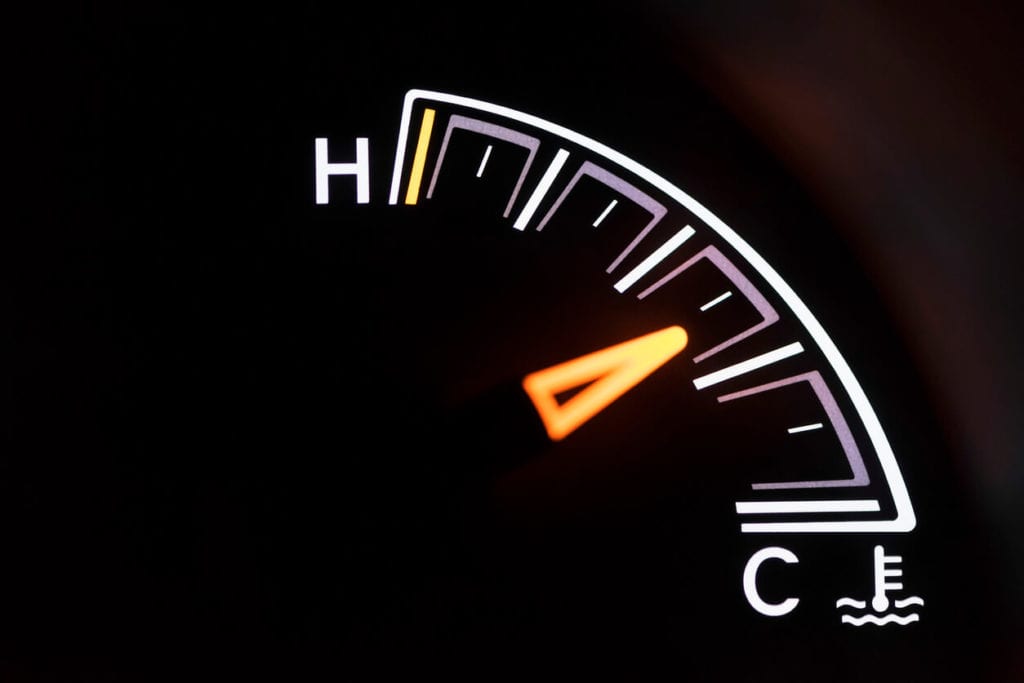
How do you keep cool in the summer? Maybe spend the day indoors watching Netflix, taking a dip in the pool, or consuming copious amounts of ice pops and ice cream? These are all great ways for humans to cool off this summer, but what about your car? Your car’s engine is enduring about 250 degrees of heat in the summer. Luckily, your car comes with coolant to help it keep its cool. There are things you can do, though, to keep your engine from getting too hot this summer, ensuring a trouble-free summer vacation road trip or the commute to work under the blistering sun.
What Keeps a Car Engine Cool
The job of the cooling system is to remove heat from the engine to operate in appropriate temperatures. The cooling system is made up of the water pump, radiator, thermostat, hoses, and coolant.
The star of the cooling system is coolant. In older vehicles it contained a mix of water and ethylene glycol often referred to as antifreeze, however, in modern vehicles it is now a mixture of Organic Additive Technology (OAT). In addition to living up to its namesake of keeping the engine cool, it is used to keep the water pump lubricated, and raises the boiling point of water in warmer temperatures and lowers it in cold while preventing the engine from developing rust and deposits.
The water pump is driven by either the fan belt or timing belt. The pump transfers coolant from the radiator, through the engine, and back again. The pump is equipped with a shaft that has a pulley on one end and a pump impeller on the opposing side. When the pulley is turned by the belt, the impeller transports the coolant.
A radiator has a series of thin conduits, called tubes, that coolant flows through and is cooled by air flowing over the fins surrounding the tubes. Well maintained coolant helps keep the fins from becoming clogged in the radiator. Regular coolant flushes help to keep your radiator working optimally.
The thermostat in your cooling system is a valve that controls the flow of coolant to the engine. When the engine reaches a certain temperature, the thermostat opens allowing the coolant to flow through to cool. Conversely, when the temperature is below the precise temperature, the thermostat prevents the flow of coolant to allow the engine to heat up to temperature. Thermostats can become stuck in either the open or closed positions. A closed position prevents cooling causing overheating while an open position causes the vehicle to run too cold, affecting fuel efficiency.
The hoses are the channels for which the coolant is transferred from the radiator to the water pump and from the engine to the radiator. Hoses are made up of rubber composites and overtime will begin to dry and crack. They breakdown from the inside and are often undetectable to the naked eye. Hoses should be flexible but not spongy.
How to Keep Your Car Engine Cool in the Summer
It’s important to note that your engine can overheat even on the coldest day in the winter. While the engine is certainly hotter in the summer due to the outside temperature, if the cooling system is dysfunctional, your engine will overheat. Here’s what you should do, or have a trusted technician do, throughout the year to keep your engine from getting too hot:
- Check belts and hoses, looking for cracks or soft spots.
- Look for signs of a coolant leak by checking coolant levels often and checking the ground under the car for leaks.
- Have coolant flushed every 30,000 to 50,000 miles to rejuvenate fluid and remove corrosion within the system.
- Visually inspect radiator cap for deterioration of the rubber seal and replace if worn.
Another way to prevent your vehicle from overheating is by being proactive. While you should always glance at your temperature gauge, it’s especially important if you’re sitting in traffic, hauling a heavy load, or going uphill. Observe the needle, is it staying in one place or is it creeping up, closer to the ‘H’? If it gets a little too close for comfort and you fear the car is in the beginning stages of overheating, try the following:
- Turn OFF the air conditioning – We know this is uncomfortable, especially in these sweltering temperatures. By turning off your AC, you’re reducing the strain placed on your engine and may help get the temperature back down to normal.
- Turn ON the heat – Yep, you read that right. It sounds completely counterintuitive but by doing this, you’re transferring heat away from the engine and it opens up the heater core which is another small radiator for extra capacity, giving your engine a chance to take in fresh air.
- Get revved up – While sitting in traffic or at a stoplight, shift your car into park or neutral and rev up the engine. Revving the engine helps increase the movement of air and water throughout the radiator.
- Pull over – If you’ve tried all of the above, the temperature gauge continues to rise, and you believe it is inevitable that the engine is going to overheat, pull over. Raise your hood to allow the engine to cool. Do not touch anything for at least 30 minutes, especially the radiator cap. Removing the radiator cap any time after driving could result in serious injuries to you or others. Finally, have your vehicle towed to a trusted auto repair facility for repairs.
